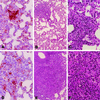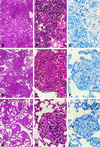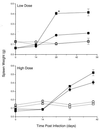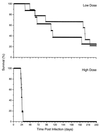Immunopathologic effects of tumor necrosis factor alpha in murine mycobacterial infection are dose dependent
- PMID: 11083819
- PMCID: PMC97804
- DOI: 10.1128/IAI.68.12.6954-6961.2000
Immunopathologic effects of tumor necrosis factor alpha in murine mycobacterial infection are dose dependent
Abstract
In experimental mycobacterial infection, tumor necrosis factor alpha (TNF-alpha) is required for control of bacillary growth and the protective granulomatous response, but may cause immunopathology. To directly examine the positive and detrimental effects of this cytokine, a murine model was used in which different amounts of TNF-alpha were delivered to the site of infection. Mice with a disruption in the TNF-alpha gene (TNF-KO) or wild-type mice were infected with low or high doses of recombinant Mycobacterium bovis BCG that secreted murine TNF-alpha (BCG-TNF). Infection of TNF-KO mice with BCG containing the vector (BCG-vector) at a low dose led to increased bacillary load in all organs and an extensive granulomatous response in the lungs and spleen. The mice succumbed to the infection by approximately 40 days. However, when TNF-KO mice were infected with low doses of BCG-TNF, bacillary growth was controlled, granulomas were small and well differentiated, the spleen was not enlarged, and the mice survived. Infection with high inocula of BCG-TNF resulted in bacterial clearance, but was accompanied by severe inflammation in the lungs and spleen and earlier death compared to the results from the mice infected with high inocula of BCG-vector. Wild-type mice controlled infection with either recombinant strain, but showed decreased survival following high-dose BCG-TNF infection. The effects of TNF-alpha required signaling through an intact receptor, since the differential effects were not observed when TNF-alpha receptor-deficient mice were infected. The results suggest that the relative amount of TNF-alpha at the site of infection determines whether the cytokine is protective or destructive.
Figures






References
-
- Bean A G, Roach D R, Briscoe H, France M P, Korner H, Sedgwick J D, Britton W J. Structural deficiencies in granuloma formation in TNF gene-targeted mice underlie the heightened susceptibility to aerosol Mycobacterium tuberculosis infection, which is not compensated for by lymphotoxin. J Immunol. 1999;162:3504–3511. - PubMed
-
- Bekker L G, Maartens G, Steyn L, Kaplan G. Selective increase in plasma TNF-α and concomitant clinical deterioration after initiating therapy in patients with severe tuberculosis. J Infect Dis. 1998;178:580–584. - PubMed
-
- Beutler B, Cerami A. Tumor necrosis, cachexia, shock, and inflammation: a common mediator. Annu Rev Biochem. 1988;57:505–518. - PubMed
Publication types
MeSH terms
Substances
Grants and funding
LinkOut - more resources
Full Text Sources
Medical
Molecular Biology Databases
Research Materials

